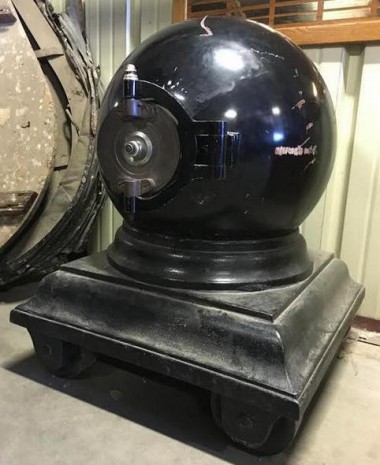by Adam Michalski

Transporting valuables in modern times is relatively easy. Armored vehicles, utilizing reinforced bodies and bullet-resistant windshields while traveling on paved roads, deliver cash between banks or jewels to jewelry stores. In the 1890s, however, transporting cash, gold, and silver was much more difficult, especially in remote Central Nevada. There were few railroads and no paved roads to speak of in Central Nevada. Strongboxes on stagecoaches were susceptible to theft. One mining camp named Berlin, however, had a unique way of hauling fortunes out of town. This is the story of Berlin and the Cannonball Safe.

Berlin, 60 miles south of Austin, developed early as a mining camp. The first mines were developed at Union Canyon in May, 1863 as the Union Mining Company. In addition to Berlin, towns such as Ione and Union sprang up nearby to support the mine. In 1896, the Berlin Mine was established and, in 1898, the Nevada Company, owned by mining magnate James Graham Phelps Stokes of New York City, purchased numerous claims in the area. Shortly thereafter a mining boom took off in Berlin.
The mining camp at Berlin flourished for several years. At its height in 1908, Berlin supported approximately 250 residents. These residents included a variety of individuals needed to support the local mining industry, from miners and charcoal makers to merchants and a doctor. With all of this activity at the mines, a secure method was needed to transport valuable goods between Berlin and the town of Austin, location of the Nevada Company offices and the terminal for the Nevada Central Railroad.
The Nevada Company found a solution to their problem: a cannonball safe. Made to order for Phelps Stokes, the cannonball safe is spherical in design and weighs 2,400 pounds when empty. The walls of the safe are one foot thick and the interior of the vault is only ten inches in diameter. The door to the safe is unique, as well. The

six-inch thick door has a combination dial when it is in use. The door came with two removable dials to lock and open it. One was kept at the Nevada Company’s office in Austin and another was kept at the mining camp in Berlin. The dual lock-dials prevented the safe’s contents from being stolen in transit. Even if a burglar would have gotten his or her hands on the safe, it would have been virtually impossible to pour nitroglycerine between the massive door and walls to blow it up. The cannonball safe was an impressive piece of late-19th century mechanical ingenuity.
The cannonball safe played an important role for the Nevada Company. Using a twenty-horse team and wagon, the safe made a weekly round trip between Austin and Berlin. The cannonball safe was used to transport the mine payroll from the company office in Austin to the mine at Berlin. On the return trip, the safe hauled bullion smelted in Berlin to the company office in Austin. In Austin the bullion was transferred to the trains of the Nevada Central Railroad for transport to Battle Mountain and other destinations.

Around 1908, the mining boom in Berlin went bust. When the boom ended approximately $849,000 (approximately $22.6 million by 2015 standards) worth of minerals were extracted from the mines at Berlin. Much of this gold and silver probably departed Berlin in the cannonball safe. By 1911, Berlin, once a bustling mining camp in Central Nevada, was dead and the cannonball safe was no longer needed for its intended purposes. Eventually, the safe fell into the hands of Mr. J. M. Hiskey, general manager of Nevada Central Motor Lines (successor to the Nevada Central Railroad). Mr. Hiskey allowed Hollywood to use the cannonball safe in films when it was not stored in his office.
Berlin and the cannonball safe still exist today. Berlin survives as part of Berlin-Ichthyosaur State Park. Nevada State Parks preserves the mining camp in a state of arrested decay, meaning that the original buildings at the site will be maintained to a level that will prevent them from falling over or decaying naturally. Meanwhile, the cannonball safe can be found on display at the Nevada State Railroad Museum in Carson City. These unique treasures played an important role in Nevada history.
Adam Michalski is Curator of Education at the Nevada State Railroad Museum.









